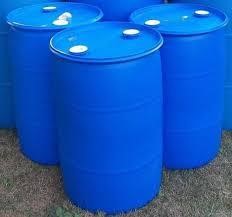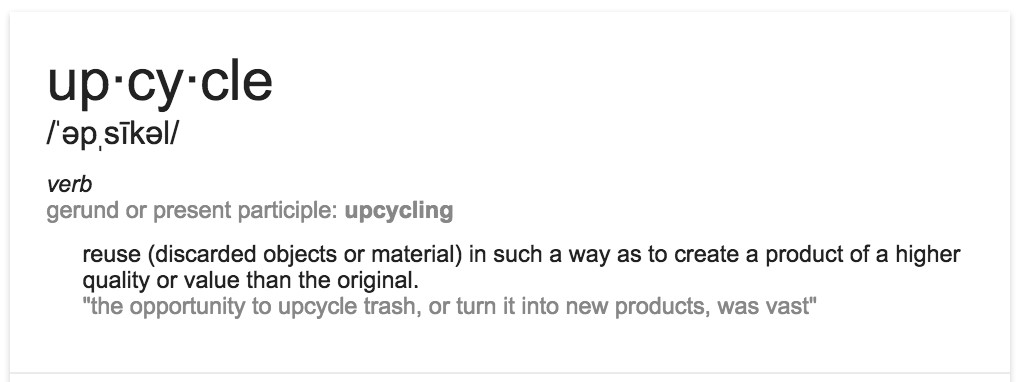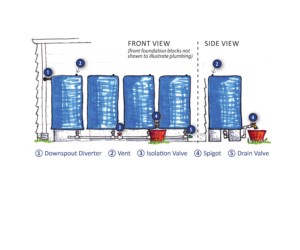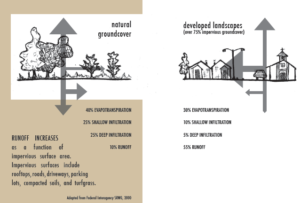By Guest Blogger, Jesse Savou, founder of BlueBarrel Rainwater Catchment Systems
Have you ever seen blue plastic barrels lying around – in refuse yards, along the side of the road, or maybe even in your neighbor’s garage? If you haven’t yet, start paying attention, because these blue food-grade poly-drums are EVERYWHERE.

Why? The reason is simple – they are manufactured by the thousands to ship liquid food products safely and securely all over the globe. But food producers want what’s inside the drums – the barrels themselves are a byproduct. So once the contents are used up, the barrels usually become part of the waste stream.
But wait a minute, how could we possibly afford the landfill space to throw away literally millions of these durable plastic barrels? The good news is these drums are such high quality that they have many alternative uses. They are perfect for upcycling.
Here’s a word that wasn’t on your SATs – but maybe it should have been:
Upcycle: to reuse (discarded objects or material_ in such a way as to create a product of higher quality or value than the original.

One popular way to give these 55-gallon food-grade poly drums a second life is to make them into rain barrels.
With every 1,000 square feet of rooftop generating over 600 gallons of runoff for every single inch of rain that falls on it, there’s NO climate that’s not suitable for rainwater harvesting.
To put that in perspective, you could fill eleven 55-gallon barrels with a single inch of rain falling on what would by today’s standards be considered a very small house.
So how to start?
Making Rain Barrels from Used Food-Grade Drums
The most simple rain barrel designs involve screwing a spigot into the barrel wall, cutting off a downspout and letting the water fill the barrel directly.
There are some important design and safety considerations, though. A spigot that’s too close to the ground won’t allow for easy access to stored water. Sometimes DIY-ers will raise their spigot 6” – 12” off the ground, but that won’t give the user any access to the water that’s trapped below it, and a messy sediment layer will develop at the base of the barrel.
Mosquitos will be attracted to standing water, so it’s important to cover all openings with 1/16” mesh (e.g. fiberglass window screen) to prevent mosquitos from breeding.
Overflow is another thing to consider. With so much runoff generated even from tiny rooftop surfaces, what happens when the barrels fill? Letting it just spill over the top can lead to obvious problems.
BlueBarrel Rainwater Catchment Systems offers a simple solution for creating multi-barrel rain collection systems, accounting for all the important considerations above.
The BlueBarrel System is plumbed from the bottom to allow for full drainage and minimal sediment buildup. The unique, vented, closed-system design keeps mosquitos away and doesn’t allow for algae to grow. The user-friendly downspout diverter that’s included in BlueBarrel’s “RainKit” handles overflow as well as inflow. The system meets code requirements in the state of California for a non-permitted rainwater system. That’s right – no permits are required, and better yet, many cities, counties, and water districts actually offer money-back rebates for installing BlueBarrel’s system.
THE BLUEBARREL RAINWATER CATCHMENT SYSTEM:

Diagram courtesy of BlueBarrelSystems.com
Find recycled barrels in your region on BlueBarrel’s website – anywhere in the USA! B. Stephen Cooperage is one of our barrel supplier partners serving the southern California region. BlueBarrel will ship the RainKit to your doorstep with everything you need to build your complete multi-barrel system, and you’ll get a voucher to pick up your barrels from a food manufacturer or cooperage in your region.
Check it out – it’s worth a look!
Environmental Benefits of Rainwater Harvesting
Besides upcycling materials, rainwater harvesting has a long list of other environmental benefits. When you install a rainwater catchment system you are aligning with Mother Earth in a variety of ways:
- Reducing your Draw on Stressed Systems: Aging infrastructure of municipal water systems is expensive to update, and groundwater resources are often overdrawn, especially in times of drought. When you supply a portion of your own water from the rain that falls on your roof, you reduce your draw on these stressed systems.
- Restoring the Hydrologic Cycle: In a natural landscape, approximately 50% of stormwater infiltrates into the ground, recharging groundwater. About 40% evaporates, and only about 10% becomes runoff. In developed landscapes, by contrast (e.g. our homes!), only 15% is allowed to infiltrate and a whopping 55% leaves the site as runoff! When you collect rainwater for use in your garden, you allow it to infiltrate at a more natural rate, restoring the hydrologic cycle on your site by contributing to groundwater recharge!

- Protecting your Local Watershed: According to EPA, stormwater runoff is by far the largest contributor to water pollution. When rainwater infiltrates onsite, it is prevented from entering storm drains and surface waters as polluted runoff. Left unmitigated, rainwater sheets off hardscapes collecting contaminants along the way. The ultimate damage is to waterways that receive the influx of stormwater, and to the aquatic life that live there.
- Reducing your Carbon Footprint: There is a strong nexus between energy and water in our modern world. In the state of California, more than 20% of per-capita energy use is dedicated to treating and transporting water! In turn, water is a huge component of cleaning and cooling energy generation facilities. By reducing your reliance on pumped and treated water sources, you are contributing to a collective savings in energy.
So come on – what excuse do you have? Given the abundance of collectable rainwater, even in the driest of climates, there’s no reason not to harvest it and put it to good use in your garden.
Start at BlueBarrelSystems.com for all the tools you need to plan out your catchment system, find upcycled barrels near YOU, and order your DIY kit to build it.
Rain is a gift. Harvest it!


